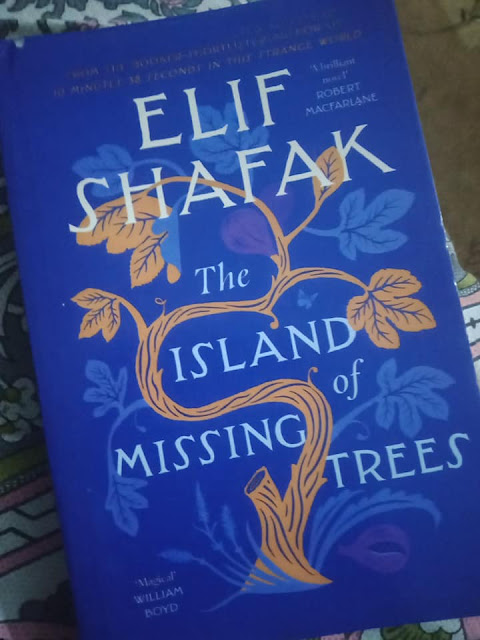Elif Shafak And The Fig Tree
Reviewer: Kaleem Butt
In recent times Elif Shafak has become a symbol of a wonderful
storyteller, whose writings have the ability to move the hearts of readers. As
a reader one could easily judge Elif’s unique style by the way she narrates her
story, and as a reader I could say that Shafak is one among many writers who
have restored my faith in stories, we need stories to survive, it is from these
wonderful stories we get hope to live in this world full of evils.
How can we ignore stories
when we are made up of stories, but when I started to lose hope in them,
authors like John Barth, Gunter Grass, Jose Saremago, Murakami, Orhan Pamuk, J
K Rowling and Elif Shafak came in my life and I was driven back to this
fantastic world of literature.
To be honest with you dear
readers, I had nothing against the stories but the way they were told, it
seemed that the storytellers had lost the way on this wonderful road of
storytelling, and things were starting to fall apart, till these abovementioned
wonderful storytellers came for rescue.
A lot has been written on
the importance of stories, but I want to share with you what Shafak has to say
about them in her booklet “How to stay sane in an age of division”, written
during Covid-19 pandemic, Shafak mentions that:
“Not to be able to tell your story, to be silenced and shut out,
therefore is to be dehumanised. It strikes at your very existence; it makes you
question your sanity, the validity of your version of events. It creates a
profound and existential anxiety in us. In losing our voice something in us
dies.”
She further writes:
“It is mostly through stories that we learn to think, perceive,
feel and remember the world in a more nuanced and reflective way. As we gain a
better understanding of the struggles of people from different backgrounds, and
start to imagine lives beyond the one we are living….”
What fascinates me most
about Shafak’s writings is that she has got a wonderful way to express
different things and the reader is driven deep into the world Elif tries to
create through her imagination, probably that’s the reason her novel “10
Minutes 38 Seconds in this Strange World” was nominated for the Booker Prize, I
still wonder why that novel, with such a marvelous story was unable to win the
Booker!
Recently I came across
Elif’s latest novel “The Island of Missing Trees” and after reading “Three
Daughters of Eve” and “10 Minute 38 Seconds in this strange world”, I fell in
love with Shafak’s way of narrating a story for the third time. This wonderful
novel is full of love and compassion fully satisfies the pleasures of reading
literature.
Allow me to quote William Boyd’s words to
support my claim, as he mentions about this novel that: “a wonderfully
transporting and magical novel…” or Polly Samson, who writes: “this is an
enchanting, compassionate and wise novel and storytelling at its most sublime.”
I can quote you many
wonderful things about this novel, but what moved me the most was the story of
the fig tree, in the novel the fig tree is a narrator and narrates the
importance of fig tree.
‘I am a Ficus carica, known as the edible common fig, though I
can assure you there’s nothing common about me. I am a proud member of the
great mulberry family of Moraceae from the kingdom of Plantae. Originating in
Asia minor, I can be found across a vast geography from California to Portugal
and Lebanon, from the shores of the Black Sea to high hills of Afghanistan and
the valleys of India.
Burying fig trees in
trenches underground during the harshest winters and unearthing them in spring
is a curious if well-established tradition.’
This is how the fig tree introduces itself in the novel and becomes
an important character of the novel, with its unique story, that keeps on
moving the reader to read and know more about the tree and fall in love with
it.
Yes sir! We are talking about the very same
fig tree that was cursed by Christ never to bear fruit again. But the fig
survived and now has started to tell its story. It takes us back to the ‘Garden
of Eden’ by mentioning that Adam and Eve never ate an apple, it was the fig
that they ate, don’t believe me or the fig tree, but at least listen to the
poor fig tree what it is trying to tell you:
‘Throughout history I have seduced into my canopy droves of
birds, bats, bees, butterflies, ants, mice, monkeys, dinosaurs….and also a
certain confused couple, wandering around aimlessly in the Garden of Eden, a
glazed look in their eyes. Make no mistake: that was no apple. It is high time
someone corrected this gross misunderstanding. Adam and Eve yielded to the
allure of a fig, the fruit of temptation, desire and passion, not some crunchy
apple. I don’t mean to belittle a fellow plant, but what chance does a bland
apple have next to a luscious fig that still today, aeons after the original
sin, tastes like lost paradise…’
In my humble opinion this
novel is Shafak’s masterpiece, every page of this 300 plus pages novel gives
hope, it makes you to laugh and cry at the same time, and when you reach the
end, you feel something has changed inside you, you want to become closer to
the nature and you want to love and respect it.
Though I wanted to review the whole novel but
it was the fig that seduced me as it had seduced the birds, bees, bats,
butterflies or Adam and Eve in the Garden of Eden. For me it is the beauty of
Elif’s storytelling in this novel that has tempted me to stay more in this
wonderful world of fiction.
(Kaleem Butt is a Sindhi novelist and journalist from Jamshoro, Sindh).






Comments
Post a Comment